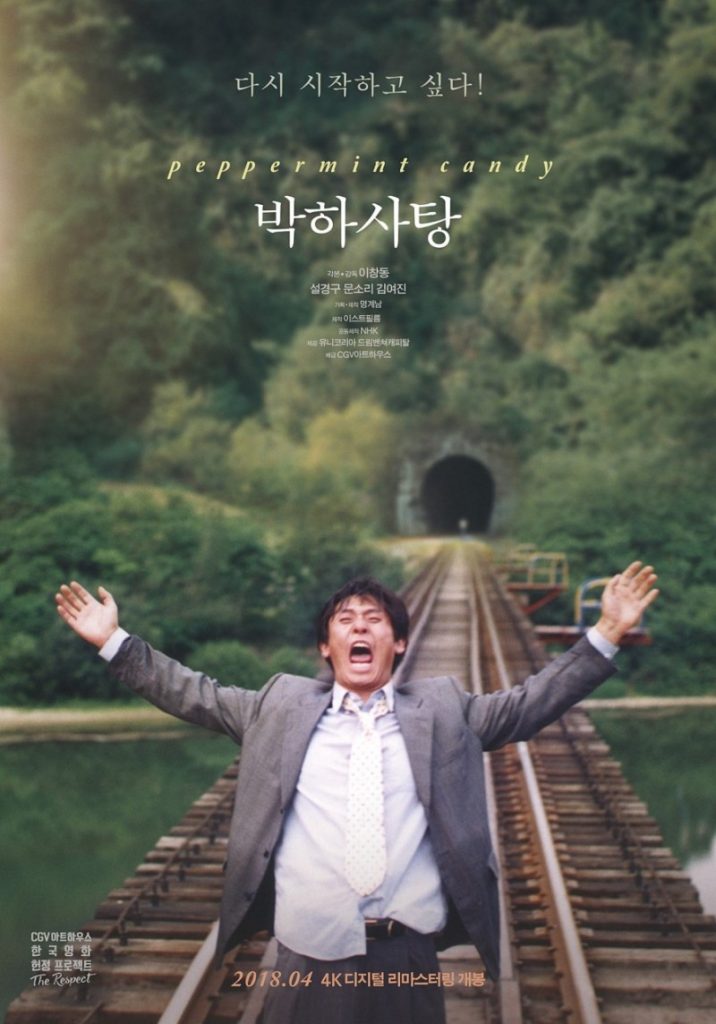Peppermint Candy
Introduction
I have been a huge fan of Lee Chang-dong since I watched Burning. I was so impressed with his unique narrative style and solid character development so I decided to follow his filmography. After Burning, I watched Secret Sunshine which is another masterpiece. I then watched Oasis and Peppermint Candy both by one of my favorite Korean actors Sol Kyung-gu. Peppermint Candy is the second feature of LCD and was considered as among the classics of modern Korean cinema. It was chosen as the opening film for Busan International Film Festival and had a plethora of awards from various film festivals like Karlovy Vary International Film Festival, Bratislava International Film Festival, Cine21, Grand Bell Awards, Blue Dragon Awards, and Baeksang Arts Awards. Peppermint Candy is among my Top 5 Korean movies primarily because of its screenplay and visuals that are so ahead of its time and acting performance that is definitely among the strongest I’ve seen in the Korean industry. Read on as I point out in detail why I like this film.
Story, Frames & Score
The story opens with a man lying under the railroad bridge with so much remorse in his eyes. From the look of him, he lost all the hope in the world, and at the state of depression, and of giving up. He gatecrashed his former club’s get-together picnic and later on committed suicide by standing on the rail track and awaited his demise by facing the approaching train. He then shouted with all his strength saying “I going back”, which he did or his life story did to be exact. As the train travels backward, so his life is presented in reverse chronology. Backtracking from his suicide as a broken and depressed man, this film recounts the life of Yong-ho, from his tragic demise to his innocent and idealistic youth, in reverse order. In between, he is a student with photography aspirations, a solider, a police officer, and eventually an investor who losses a small fortune in the stock market. He is also a husband, but his marriage to Hong-ja leaves them both unhappy as Yong-ho continues to obsess over his first love. The movie is divided into six fragments of Yong-ho’s life: The Camera – 1999 just 3 days before his suicide, Life is Beautiful – Summer of 1999, Confession – Spring of 1987, Prayer – Fall of 1984, Military Visit – May of 1980, and Picnic – 1979.
Lee Chang-dong is known for his brilliant use of visual storytelling. Therefore, in this film, it is noticeable how cinematography plays a vital role in the development of the story. DOP Kim Hyung-koo who is behind the camera of the cult classic Memories of Murder and another remarkable film The Host both by Bong Joon-ho proved that way before these masterpieces, he already had his magical touch. In Peppermint Candy, the audience is in awe of his realistic depiction of the various era in South Korean history. With the backdrop of the Korean economic boom, the life of Yong-ho unfolds from an agonizing ending to a vibrant youth. As I mentioned earlier about the brilliance of the visual storytelling, each segment of the story starts with the train moving backward while everything else moves forward. Other recurring motifs are peppermint candy, water, streams, train, and train tracks symbolizing innocence, memory, time, and fate. Other details that need to be mentioned are the opening and closing frames. They happened at the same place, and the MC has the same look in his eyes but they are of different timeline
This already poignant story was made even more heart-wrenching by the heart-rending background music and soundtracks. The opening song was sung with deep anguish. That same song was sung on the closing scene however, it was lively at that sequence. The use of the same song at the beginning and end of a film is an intelligent technique of depicting how a person’s perspectives could make a different interpretation of the song and life itself.
Performances &Dialogues
Kim Yong-ho is introduced as an unlikeable character as he explicitly shows how he loathes himself and the world in the opening sequences of the film. His character depicts the issue of masculinity in South Korea where men are to render mandatory military service, which in turn resulted in a traumatic event that made him lose his innocence. Later on, such shattered masculinity resulted in his violent treatment of his wife and abuse of authority. Sol Kyung-gu playing Kim Yong-ho shows excellent character depiction despite the fact that this is his first lead role. This is one of the films I’ve seen that the actor seems like not acting at all. He is so into his character that I feel I’m watching his real-life first hand. The line “I’m going back” says everything. He, by himself, is one of the reasons why this film should be watched. His character arc is superb. How he changes his personality as time passes is compelling. His performance here enables him to win 4 Best Actor awards from various film festivals. The makeup artists are commendable for making his physical transformation with 20 years timeline difference realistic. Kim Yeo- jin also did an outstanding performance in giving life to Hongja. Another flawed character in the story whose life was ruined by circumstances. Moon So-ri, on the other hand, gave justice to her role as Yun Sun-im. Her innocent smile and refined character are memorable. The emotional dynamics of the characters were perfectly captured by close-up range shots.
Screenplay & Direction
I have to say that this film has a brilliant screenplay. The reverse chronological order of events was artfully established. The use of foreshadowing is spot-on. Starting a film with a climax is quite bold and will make you wonder how everything will fall into place. When you reached the last frame you will surely be amazed at how everything fits together like a jigsaw puzzle. Such is a clear manifestation of how brilliant Lee Chang-dong is. Sharing this commendation about the plot consistency is the film editor Hyun Kim. His keen editing enables the film to be tight, and solid. This character-driven narrative unfolds how Yong-ho has driven away from his aspiration as a youth in parallel with the agonizing political history of South Korea. The story is divided into 7 segments and each vignette of his life narrates the past 20 years of South Korean society. Among the significant events in South Korea’s history integrated into the film are the IMF crisis (1999), South Korea’s economic boom (1994), student massive demonstration (1987), and the Gwangju massacre (1980). The well-written character development enables the audience to relate to the happiness, as well as the hardships of MC. Integration of salient historical events of South Korea, social issues, and metaphors add more depth to the story. Lee Chang-dong’s craftsmanship enables him to create a histographical movie from a man’s perspective. After watching the protagonist’s life in reversed order we understand how life and society turned him from an innocent, enthusiastic lad to a wasted, good for nothing suicidal man. In the end, society is the antagonist………
Conclusion
Peppermint Candy is a powerful drama that stands out because of its political element. It is a stirring portrayal of man’s disintegration, and a society’s cruelty ruining youth’s innocence and aspirations. The movie leaves an unspeakable agony and regret that resonate with the audience. The train and the train track as central metaphors of the film depict fate and the pre-determined life of each individual and we just like the train had no control over what we called destiny. The film also engages the viewers in retrospection about life and contemplation whether to live in the past or to move forward.
Disclaimer: The above review solely illustrates the views of the writer.




